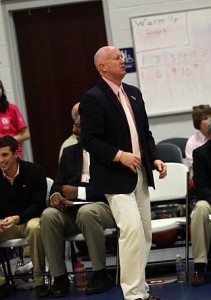In the Paint With Coach Green – December 1, 2016
 Coach Green’s Blog
Coach Green’s Blog
Volume 2
December 1, 2016
“When C’s lead to success…”. I believe that building a successful program can be defined by 6 C’s, Commitment, Consistency, Communication, Community, Culture and Competing. There is so much more to a successful program than X’s and O’s and W’s and L’s.
It starts with program Commitment. First and foremost coaches and players have to be committed to each other. Then players have to be committed to each other. When you have that commitment it automatically breads TRUST. When players and coaches trust each other great things can be accomplished. But commitment goes beyond the boundaries of the gym floor. It requires commitment from the support staff (Trainers, Statisticians, Managers, Videographers, Cheerleaders, etc.), administration, the student body, and fan base. When all dimensions of a program are committed to each other, success will happen.
After Commitment comes Consistency. Successful programs are consistent in everything they do. Successful teams are made up of players, coaches and staff that are consistent in their practice effort, their game preparation and their effort in the game. There are times when you may run into a bigger, faster, stronger team, but if you stay consistent and work the process, you will be better for it in the long run.
Communication is one of the most important keys in building a successful program. This includes communication at many different levels (i.e. developing a common vocabulary and then maintaining a commitment to use that vocabulary throughout the program). Communication must flow between many (i.e. player to player, coach to player/player to coach, coach to coach, coach to community). Communication must be honest and sincere. It must be delivered with care and clarity. At the same time, listening is just as important. The ability to listen and act accordingly to instruction, criticism and praise is a learned/practiced skill.
The fourth C is Community. Webster’s definition of community is “A unified body of individuals. The people with common interest living in a particular area.” Our community is and should be far reaching. We have our student body/fan base community, but we see our surrounding neighbors as our community too. We are constantly looking for ways to support our wider community. An example was our volunteer work at The Miracle League of Triangle. In John 13:34-35 we are commanded to love one another. If we want fan support then we owe our support to our community.
Culture is a C that is crucial when building a successful program. Developing a culture is vital. We strive to create a culture of consistency, hard work, and discipline. Our program is currently studying Coach John Wooden’s “Pyramid of Success” on Leadership. With success comes expectations. It should be any program’s goal to develop a successful program.
The first and most important step in the process is defining “success” for your team. Our definition of success is “How hard we compete? If we compete as hard as we possibly can, the score on the scoreboard will take care of itself.” We will be successful because we competed. That is “How hard we compete in practice?” “How hard we compete during a game?” “How hard do we compete in the class room?” Our goal is to never take a play off and to never take a homework assignment, quiz, test or project off. If we compete every day in practice, if we compete every possession of our games, then we will put a product on the court that our community will want to come out and support.
Are we there yet? No. But we are “working the process” with the goal to always compete! Over my next few blogs I will describe our Mission Statement, Vision Statement, Goals and Core Values as well as detailing our progress with the Pyramid of Success.
Compete
Sincerely,
Coach Green
“A coach will impact more people in one year than the average person will in an entire lifetime.” Rev. Billy Graham
